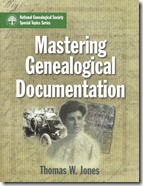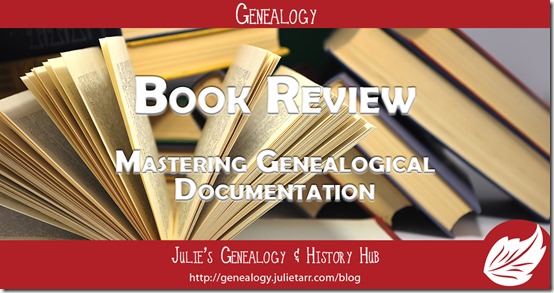 Title: Mastering Genealogical Documentation
Title: Mastering Genealogical Documentation
Author: Thomas W. Jones
Format: Paperback, Kindle
Published: 2017
My Rating: ![]()
![]()
![]()
![]()
The following review first appeared in the Federation of Genealogical Societies FORUM magazine (Spring 2018); reprinted with permission.
Mastering Genealogical Documentation is a workbook-style guide that assists family historians with the citation-writing process. Many genealogists are familiar with Evidence Explained, by Elizabeth Shown Mills, and might question the need for Mastering Genealogical Documentation. As Dr. Jones explains in his preface: “[Mastering Genealogical Documentation] is not a reference book providing models for citing kinds of sources. It does not discuss guidelines for myriad source types” (xvi). Instead, Mastering Genealogical Documentation provides an in-depth look into crafting source citations that meet genealogical standards. In other words, this book gives researchers the logic behind what goes into a citation, thereby assisting the researcher with sequencing elements and allowing the researcher to decide what elements to include in certain situations, such as working notes or works ready for publication. Exercises at the end of each chapter help readers practice the discussed techniques and apply what they learned.
Understanding a source’s purpose and the information it contains is key to properly analyzing it and using it as evidence in a genealogical conclusion. This same understanding is what helps craft an accurate source citation. While the book discusses reference-list citations, the main focus is on reference-note citations. Each has its own style and purpose, but both answer four basic questions about a source: who, what, when, and whereis. Because a reference note cites a specific element, it answers an additional question: wherein. When researchers can effectively answer the five questions, they can appropriately craft a reference-note citation and thereby demonstrate their understanding of the source.
The majority of the book addresses the five questions, providing various options and examples. Readers will learn the logic behind certain long-standing conventions, which is essential to understanding how to properly write a source citation. For example, a source’s publication status will dictate how a citation is crafted, based on those established conventions. Whether a source is online or offline also can impact citation elements. All of these considerations, and more, are thoroughly covered in this book.
In addition to the nitty-gritty logic behind crafting source citations, this book discusses other relevant points such as formatting conventions, which includes a discussion on punctuation and style. One chapter thoroughly explains the difference between reference lists and reference notes, which are often confused, providing examples and discussing instances when each would be used. Another chapter offers advice for the placement of reference notes (footnotes, endnotes, etc.) and placement of note numbers within a narrative.
The chapter exercises are thought-provoking and challenging, many utilizing an article published by the author (reprinted in appendix A). The answers, provided in a section at the end of the book, help further explain a concept.
Readers will no doubt gain a better understanding of the “how” and “why” behind source citations after reading this book. With that knowledge, readers will be able to appropriately evaluate and cite any source, including those that are unusual or obscure, where no model exists.



Share your thoughts...